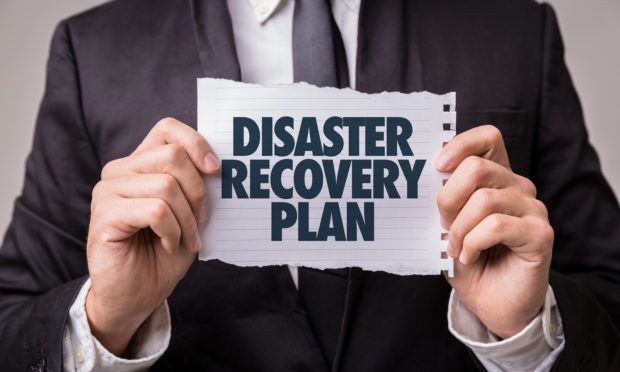Businesses and their leaders have a unique role to play in helping communities and individuals recover from the devastation of a storm like Hurricane Harvey, and they should not underestimate the power of getting employees back to work and re-establishing routines in relief and recovery, according to an expert in recovery.
“Returning to work is returning to life,” believes Jeff Gorter, of the business consulting firm R3 Continuum.
Returning to work restores a sense of control amid the chaos, a feeling that can then extend to other areas in life, according to the disaster recovery specialist. Gorter has been the clinical director at R3 Continuum for the past 13 years and says he has, unfortunately, responded to many large-scale events like Hurricane Harvey.
His employer, Wyoming, Mich.-based R3 Continuum, helps organizations prepare for and handle disruptive events, including natural disasters, mass layoffs, workplace violence and complex claims situations. The firm helps get businesses back on track and employees back to work.
In a timely webinar, “Hurricane Harvey: The Role of the Employer in Relief and Recovery,” Gorter shares information that organizations and business leaders have found helpful as they have responded to disasters like Hurricane Harvey.
Hurricane Harvey was a devastating storm, taking more than 82 lives, causing the evacuation of more than 42,000 people to emergency shelters and damaging more than 100,000 homes. Also, it destroyed or damaged more than a million cars—which may seem minor in the scheme of things, but Gorter notes that transportation is a major issue for people seeking to rebuild, get emergency aid or return to work.
What’s most important after a disaster like Harvey is helping individuals recover psychologically, which allows them to then move forward physically, he says.
Gorter explains that recovery involves restoring a sense of connectedness. While faith groups, community groups, even athletic teams can provide connective relief, he maintains that the workplace also offers a source of connectedness and that employees’ ability to reconnect with their “work family” plays an important role in recovery.
“Returning to work is more than just re-establishing productivity and things of that nature, but it’s that as well because they rely on that income. It’s also true that returning to work has a tremendous psychological and emotional benefit,” he says.
Reuniting with co-workers “creates energy, encouragement, strength” and reinforces the employees’ sense that they are not alone in this difficult time.
Many employers support the Red Cross, United Way and other helping organizations and have been long involved with community groups including food pantries or shelters. Gorter suggests businesses might want to engage more with such organizations at this time while also creating opportunities for employees to engage.
“One of the things that helps keep people buoyant, that encourages their spirit, that helps them feel like they’re doing something important and effective is giving them opportunities to help. Having a team identified that can go and assist with some of the local efforts, even though they may still be recovering themselves, acting in altruistic and helpful ways is an encouragement to the spirit and lifts them up emotionally,” Gorter says.
Companies may be in a position to encourage and coordinate donations of money and supplies. Some companies are establishing banks of donated paid time off hours for those who need extra time off to rebuild or attend to injured or sick family members. Other firms are creating home rebuilding funds to help the many without flood insurance.
Harvey’s Unique Aspects
Based on contact with his firm’s own responders who are providing assistance to employers as their employees are coming back to work, Gorter cites what he says are some unique aspects of the recovery atmosphere around Harvey.
Much of the media has already moved on from Harvey or shifted to Hurricane Irma, he notes. And that is upsetting to those who must deal with the aftermath in Texas. “For the folks in Houston, throughout the region, they haven’t moved on. Things have been going forward at a crawl. There is a sense of frustration, a sense of anger that, ‘Wow, how quickly the rest of the nation turned its attention to other matters.”
He says the current political climate around immigration is influencing the recovery atmosphere, leading “many residents to have a reluctance to access or apply for aid out of fear that that might lead to deportation or other issues that could further complicate” matters.
The Harvey recovery is also being hampered by a housing shortage. Beyond the homeowners whose houses have sustained damage are renters in damaged buildings who now face eviction.
“In a house you could perhaps begin to create safe places. You could restore rooms and use that as an operating base and house yourself or your family there as you slowly go through the process of reclaiming and repairing your home. But if you’re a renter, you cannot stay in that same facility while it’s being repaired,” he says.
Business Leaders
What can business leaders, executives and managers do to leverage the power of work in recovery efforts?
“We recognize that leaders at times like this are often the face of the response. This is when all eyes are on you. The employees are looking to their leadership at a time like this. They are in a state of concern, of fear, of chaos, and they look to leaders at these times,” Gorter says.
Business executives are not immune to disasters, and many leaders and their families have themselves been through disruption and suffered emotionally. They should address their personal concerns, of course, but what leaders should not do is isolate themselves or withdraw.
“So many leaders have shared in the past that that was a mistake. As they pulled away and they were no longer visible and they were no longer perceived as accessible, then people began to doubt their leadership abilities,” says Gorter.
“It’s important to be out there and to be present with your employees, with your team, so that they can see the visible example of leadership.”
Business executives and managers should be frequently checking in with their teams, “walking the floor” and encouraging all teams to do the same. Checking in, even if only by email, reminds people they’re not alone and leverages the strength of the connectedness that the workplace offers, according to Gorter.
“This is a time when the work family [is] checking in with each other and saying, ‘Hey, how are you doing? I know it’s been a week. Hey, how’s the rebuild coming?'”
In addition to being visible, leaders must “communicate, communicate, communicate,” stresses Gorter.
“You cannot overcommunicate in a time like this. Giving short, brief updates frequently, letting people know: ‘Here’s what we know so far. Here’s what we don’t know, but once we find out, we’re going to let you know.’ Having frequent communication establishes you as a leader as a verifiable source of solid information.”
He maintains that it is a mistake to wait until all the facts are known because in the absence of real information, people will often turn to rumors and their worst possible fears.
“If you’re not out early communicating, people are going to interpret that as ‘leadership doesn’t have a plan,'” and they will feel they have to look elsewhere for information, according to Gorter.
Communications should be both “sensitive and straightforward,” acknowledging the harm that the disaster has had on the team and on each individual employee. In addition to letting employees know they care, leaders should convey that they are competent and believe that everyone is going to move through the difficulties.
Gorter has some advice for how business leaders can achieve and convey competence in a crisis: break the massive challenge into small tasks.
“The enormity of these events can easily overwhelm. It clouds the perspective. It drains the energy and leaves people to begin to doubt, ‘Can I do anything in the face of this? Look at how big this is. How am I ever going to make any difference at all?’ It’s helpful to take a step back, break the recovery efforts into smaller, more achievable tasks in order to build a sense of momentum,” he suggests.
He recommends that executives and managers make a list of small tasks for themselves and for their team. Checking them off as they are completed helps create a sense of progress.
Every company has its official executives and managers. But every firm also has its unofficial leaders. These are the people “who encourage people, who are the ones who maintain the morale and the sense of esprit de corps that a group has.” Gorter urges official leaders to reach out to these influencers.
“They may not be official leaders, but you know who they are. Seek out both the official and unofficial folks for their input,” he says, suggesting executives ask them what to do next and how the company can best aid and bring people together.
“These organic solutions are often the most effective, and they have the added benefit of immediate buy‑in because you’re having both official and unofficial leaders empowered to make suggestions like these. Hearing those ideas and empowering them to put them into effect also has a tremendous benefit to the workgroup as a whole,” he says.
Business leaders want to maintain a balance between individual needs and organizational objectives, which may involve recognizing that people are going to have different needs at different times, such as some flexibility in their schedule as they seek to rebuild, Gorter says.
However, he stresses, this does not mean putting the business on hold while individuals solve their problems. Those individual needs have to be balanced with the fact that normal business operations lend structure, predictability and familiarity to employees.
“Being able to focus on both the business needs and the individual needs in a balanced way positions you as a leader in the best possible way,” he says.
Executive Tips
Gorter shares some additional tips to help executives manage their own stress, calm themselves and learn take care of themselves:
- As much as possible, maintain regular sleep, diet and exercise. Recovery is exhausting work, and the body needs to de‑stress with physical exercise as well as be at its peak condition in order to make the next right move.
- Surround yourself with caring people. Reach out to those you know who support you in positive ways.
- Set boundaries. Now is not necessarily the time to take on additional projects or to engage in personal challenges. Recognize what your limits are and be cautious not to make impulsive decisions that you may regret later.
- Break your own recovery efforts into smaller, more achievable tasks in order to build a sense of momentum. Setting a list of things that you can check off, so you can begin to build a sense of momentum, is important.
- Give yourself and your team time. Recognize again this is a marathon, not a sprint. You will get through this, but you have to give ourselves time and “extend a little bit of grace, a little bit of understanding” to each other.
- Seek assistance from your employee assistance program, from faith mentors, from community groups, friends and others. If stress levels don’t seem to be abating, seek out professional counseling. Seeking assistance at this time reinforces that you’re not alone during this crisis.
According to Gorter, the job of a business leader is not to say “exactly the right thing in exactly the right way at exactly the right time.” There is no one way to handle recoveries.
“As a business leader, you are in that unique place to help your team feel cared for, to help your team feel competent, encouraged, to help them pull together as a unit and to capitalize on the strength that already exists,” he says. “It’s not that you have to do magic and miraculous things. Just helping them feel cared for and knowing that you are there as a company supporting them can make all the difference.”





















 Why the Middle Market Matters and How Insurers Can Capture It
Why the Middle Market Matters and How Insurers Can Capture It  What to Expect in 2026: U.S. P/C Results More Like 2024
What to Expect in 2026: U.S. P/C Results More Like 2024  First Atlantic Hurricane Forecast for 2026 Suggests Season Close to 30-Year Norm
First Atlantic Hurricane Forecast for 2026 Suggests Season Close to 30-Year Norm  Why ‘Good Enough’ Is Killing Insurance: The Hidden Cost of Satisficing
Why ‘Good Enough’ Is Killing Insurance: The Hidden Cost of Satisficing 




